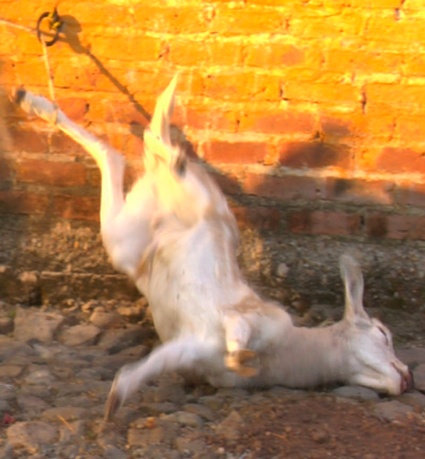The Effectiveness of Commentary
Through Cruelty
By Chelsea Burk
WARNING: This blog contains graphic images. Please view at your own discretion.
Animals have been used in art for thousands of years. Painted deep within caves along the walls as a form of magic, or placed within the masterful paintings of the Renaissance as symbolic forms for human emotions, animals are intrinsically linked in art since its beginning, and even to present day.
But how has the role of animals mutated within the art created over the last few decades? An examination of several artists and their controversial works concerning the issue of animal abuse, questions the line between freedom of speech and animal cruelty, and ends up turning a finger upon society itself.
Conceptual Art
The artists accused of committing animal cruelty are classified as conceptual artists. As summarized by the Stanford Encyclopedia of Philosophy, the point of conceptual art is “to make us question our assumptions not only about what may properly qualify as art and what the function of the artist should be, but also what our role as spectators should involve, and how we should relate to art.” Philosophy carries much weight in the realm of art, and especially so in conceptual art. It questions not what we look at, but how; as well as challenging our status as viewers of art.
With this summary in mind, controversial works by several artists are examined.
The Artists
Guillermo Vargas: in 2007, the Costa Rican artist tied up a stray dog in a gallery with the words ‘Eres Lo Que Lees' ('You Are What You Read') written in dog food on the wall, played the Sandinista anthem backwards, and burned 175 pieces of crack cocaine.
The dog was obviously stray, and very emaciated. Pictures appeared on the internet, (such as the one to the right) prompting an uproar so vehement that both the Humane Society of the
Vargas commented on the controversy, pointing out that no one visiting the gallery attempted to assist the dog. Vargas also suggested the hypocrisy in one dog causing this outrage, yet thousands of stray dogs fill the city’s streets.
Questions exist about this being a publicity stunt, and the dog’s true fate is unknown. The gallery director is stated as saying the dog was only tied up for 3 hours, fed and watered, and then escaped. Because Vargas has never commented on the fate of the dog, it is unsure what ultimately happened.
 Guillermo Vargas, "Exposicion No.1", 2007
Guillermo Vargas, "Exposicion No.1", 2007
Damien Hirst is an established British artist famous for placing dead animals in tanks of formaldehyde. Though normally obtaining the animals from “knackers”, where old or sick livestock are to be killed whether an artist needs one or not, the shark in the piece titled “The Physical Impossibility of Death in the Mind of Someone Living” created in 1991 (pictured below) was captured and killed, but later began to deteriorate. A new shark was again captured and killed to replace the previous shark.
Adel Abdessened, a French artist, exhibited a video entitled “Don’t Trust Me”, a looped video showing six animals being bludgeoned to death.
Abdessened filmed their deaths in a Mexican slaughterhouse, where they had been raised to be slaughtered for their meat. As writer Brian Clark Howard states in his article “Is It Wrong to Kill Animals for Art?”, “it would have happened even if the artist wasn’t there”. When it was shown at a gallery in San Francisco, public outrage caused the exhibit to be closed several days later.

Adel Abdessened, "Don't Trust Me", 2008
The Dilemma
In placing the starving dog in a gallery, Vargas ended up creating a visceral reaction shared by many people against the cruel treatment of the animal. But there are thousands and thousands of starving dogs all over busy cities, and even in America. In St. Louis alone, there are about 40,000 stray dogs (USA Today, 2008) on the city’s streets.
Damien Hirst commissioned a fisherman to catch him a large shark solely for the purposes of killing it and placing it into his art piece. But according to GreenPeace’s website, “100 million sharks and rays are caught and discarded each year” as victims of bycatch; the unintentional death of sea animals in the pursuit of others, such as shrimp or tuna.
Adel Abdessened filmed what has become to be called an “animal snuff film”, causing accusations of the artist only attempting shock and publicity with his brutal video. But he was filming something that happens everyday, the acts of a Mexican butchery which exists for just this purpose.
Are these artists exploiting these animals for their own purposes; to achieve a shock factor and garner publicity? Or are they practicing conceptual art in it’s truest form; encouraging the audience to reevaluate what is being seen, and what their role becomes as witness?
Perhaps the exploitation of these animals is a necessary sacrifice; one for the realization of the many.
Photo Credits
http://www.mamapop.com/wp-content/uploads/2010/07/pickled-shark-damien-hirst.jpg
Links
http://plato.stanford.edu/entries/conceptual-art/
http://we-make-money-not-art.com/archives/2009/02/and-the-ridiculous-news-of.php
http://nymag.com/daily/entertainment/2009/05/saltz_adel_abdessemed_creates.html
http://www.greenpeace.org/international/en/campaigns/oceans/bycatch/
http://www.guardian.co.uk/artanddesign/2008/mar/30/art.spain
http://cdnedge.bbc.co.uk/1/hi/entertainment/456316.stm
http://nymag.com/daily/entertainment/2009/05/saltz_adel_abdessemed_creates.html
